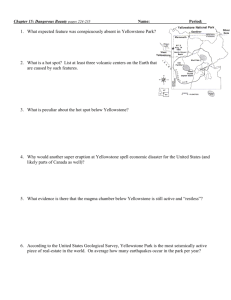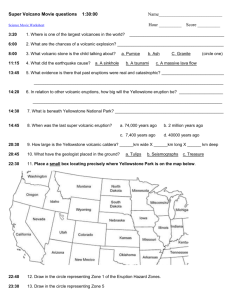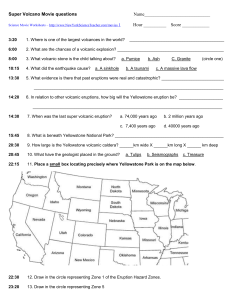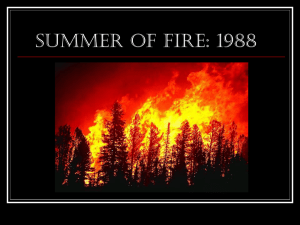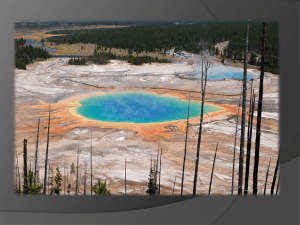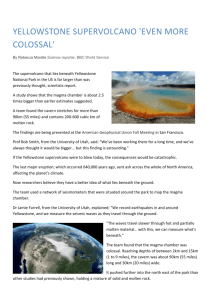WHERE AM I - Cloudfront.net
advertisement
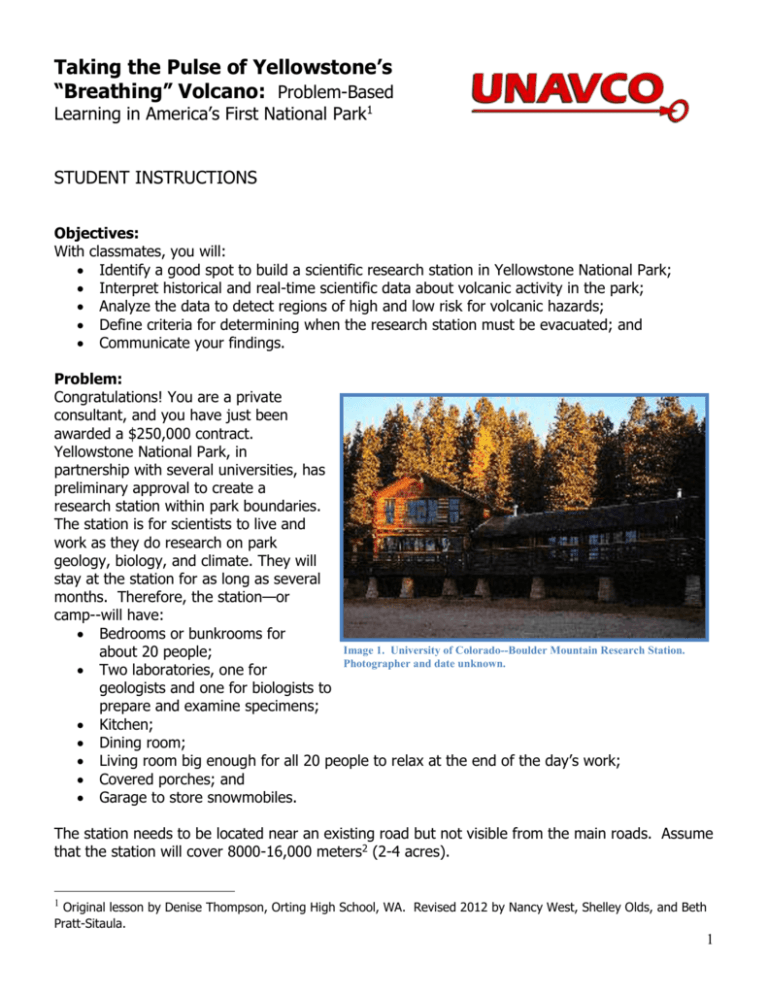
Taking the Pulse of Yellowstone’s “Breathing” Volcano: Problem-Based Learning in America’s First National Park1 STUDENT INSTRUCTIONS Objectives: With classmates, you will: Identify a good spot to build a scientific research station in Yellowstone National Park; Interpret historical and real-time scientific data about volcanic activity in the park; Analyze the data to detect regions of high and low risk for volcanic hazards; Define criteria for determining when the research station must be evacuated; and Communicate your findings. Problem: Congratulations! You are a private consultant, and you have just been awarded a $250,000 contract. Yellowstone National Park, in partnership with several universities, has preliminary approval to create a research station within park boundaries. The station is for scientists to live and work as they do research on park geology, biology, and climate. They will stay at the station for as long as several months. Therefore, the station—or camp--will have: Bedrooms or bunkrooms for Image 1. University of Colorado--Boulder Mountain Research Station. about 20 people; Photographer and date unknown. Two laboratories, one for geologists and one for biologists to prepare and examine specimens; Kitchen; Dining room; Living room big enough for all 20 people to relax at the end of the day’s work; Covered porches; and Garage to store snowmobiles. The station needs to be located near an existing road but not visible from the main roads. Assume that the station will cover 8000-16,000 meters2 (2-4 acres). 1 Original lesson by Denise Thompson, Orting High School, WA. Revised 2012 by Nancy West, Shelley Olds, and Beth Pratt-Sitaula. 1 Quick Overview of How You Will Tackle the Problem: First, you will decide where the camp should be. Plan for it to exist for at least a century, without disturbing animals or altering the astounding geological features that draw visitors. To do this, you will learn about Yellowstone National Park and its geological setting—in volcanic calderas. All of you will learn about how we monitor volcanoes, using the 1980 eruption of Mount St. Helens as an example. Then you’ll become an expert about volcanic eruptions, hydrothermal activity (and gas emissions), or earthquakes. Finally, all of you will learn about how the ground deforms. With that knowledge, an expert from each group -- volcanoes, hydrothermal/volcanic gas activity, and earthquakes—will join to form a team of three people who combine their expertise to locate the site for the camp. You will use Google Earth to analyze your data to find the perfect site. You will propose a location and explain why that is the best site within the park. Also, you will develop guidelines to establish when the risk of an eruption is too high for scientists to stay at the camp. They must evacuate—according to your guidelines, or your “Safety Protocol”. Introduction: In your team of three, or as a whole class, review the presentation, “Science of Prediction: Monitoring Volcanic Activity”. This presentation shows you how scientists monitor volcanoes. You will see the kinds of measurements scientists made before Mount St. Helens erupted and are making now at volcano observatories in the United States. Yellowstone National Park hosts the Yellowstone Volcano Observatory. Learning about the Yellowstone Supervolcano: Individually, you will become knowledgeable about Yellowstone’s volcanic history or its earthquakes (“seismicity”) or hydrothermal activity and volcanic gases. Each of the topics has its own presentation. Get together with classmates who are learning the same topic. You will be using Google Earth to analyze your data. Materials: 1. Google Earth and instructions 2. Google Earth data files 3. PowerPoint presentations to review for background information. Procedure: 1. If you have not already, get familiar with Yellowstone as viewed in Google Earth. View the landscape with just the regular satellite imagery and then add the Park Map so you can see where the roads, visitor center and other human features are. 2. Each of you will become an expert in one realm of volcanic activity monitoring. Open your particular PowerPoint presentation Image 2. "First" Picture of Old Faithful Eruption. William Henry Jackson, 1872. Eruptive History Seismicity Hydrothermal These presentations describe the current and historical monitoring data at Yellowstone NP. Some slides will ask you to follow links to websites. 3. Now return to your team and learn about GPS and ground deformation. You’ll do this by working through another presentation: Deformation Data: Your data will be Google Earth files. Map overlay – for all students 200 recent earthquakes – for Seismicity 200 top earthquakes – for Seismicity Geysers – for Hydrothermal Heat – for Hydrothermal GPS deformation – for team as a whole Analysis: Now you get to assemble what you’ve learned and decide where you propose building a research station. Refer to your maps or use Google Earth to look at the data as you think about and discuss with your teammates each of the following questions. Volcanic Eruption data: How often does the Yellowstone hot spot create a new caldera? What types of volcanic eruptions are associated with Yellowstone? How are these volcanic eruptions dangerous? Where are the areas most prone to hazardous eruptions? In your professional opinion, is there an immediate (next 100 years or so) danger related to volcanic eruptions at Yellowstone? Hydrothermal Activity data: In what way is hydrothermal activity dangerous? Where would hydrothermal activity keep you from building a research station? In your professional opinion, is there an immediate (next 100 years or so) danger related to hydrothermal activity at Yellowstone? Volcanic Gases data: What gases are monitored at Yellowstone? Image 3. Castle Geyser, Upper Geyser Basin. Thomas Moran, undated. In what way are these gases dangerous? Where are the areas that are most dangerous? In your professional opinion, is there an immediate (next 100 years or so) danger related to release of volcanic gases at Yellowstone? Earthquake Activity data: How are earthquakes dangerous? How many modern day large (greater than magnitude 5) earthquakes have occurred at Yellowstone? What is the most common magnitude of earthquakes recorded at Yellowstone? Does the pattern of earthquakes at Yellowstone suggest movement of magma? (Remember the pattern at Mount St Helens. Where would earthquakes most likely affect a research station? In your professional opinion, is there an immediate (next 100 years or so) danger related to earthquakes at Yellowstone? Ground Deformation data: In what way could ground deformation be dangerous? What deformation do you observe in the historic data? What deformation do you observe in the real-time GPS data? Why might the leveling data be different than the GPS data? (Think about how and when each is measured.) Does uplift or subsidence affect some areas more than others? Would this affect where you might put your research station? In your professional opinion, is there an immediate (next 100 years or so) danger related to ground deformation at Yellowstone? Conclusions: Read the problem on the first page again. Now, use Google Earth, and what you’ve discussed in your group, to agree as a group upon the best place to build a two-four acre research station. It may help you to draw polygons in Google Earth (see Guide) around regions you consider not appropriate to help narrow down your regions of interest. Prepare Your Recommendations: How you do this depends on what your teacher assigns. For instance, you might Image 4. Tourists Wading in Great Fountain. Artist unknown, 1908. make an oral presentation or write a paper or glossy brochure, or some combination of those. No matter what your assigned format is, you will want to: Restate the problem—remind the research group of what they are paying you to do. Summarize your data—they don’t have expertise or time. That’s why they hired you. Explain to them what data you collected and what it means. Make your recommendations—be specific as to where you think it is appropriate for research station to be. Support your recommendations—explain why the spot you recommend is the best spot. Use specific details from your data. You should also describe any further data collection that you recommend. Make your case in a conclusion by emphasizing the important points. Also, if you’ve been asked to do this, draft guidelines that will be used to decide if and when scientists (and tourists nearby) must be evacuated in order to keep them safe. How many guidelines and what kind of data you use is up to you. Consider saying something like, “If an earthquake swarm occurs and lasts for x months, then….” Or, if geysers in a geyser basin begin erupting unusually, then....” Or, “If heat values seen on LandSat images exceed x, then….” (The last refers to data visible on Google Earth.) Image Sources Image 1. University of Colorado Mountain Research Station’ Wildrose Dining Hall. Photo. Photographer unknown. Date unknown. http://www.colorado.edu/mrs/setting-facilities Retrieved 26 March 2012. Image 2. William Henry Jackson. “First” Picture of Old Faithful Eruption. Photograph. 1872. Yellowstone Digital Slide File k# 64,176. http://www.nps.gov/features/yell/slidefile/history/jacksonphotos/Page-2.htm Retrieved 24 March 2012. Image 3. Moran, Thomas. Castle Geyser, Upper Geyser Basin. Watercolor. No Date. Yellowstone Digital Slide File. http://www.nps.gov/features/yell/slidefile/history/moranandotherart/Page-1.htm Retrieved 24 March 2012. Image 4. Artist unknown. Tourists Wading in Great Fountain. Photograph. 1908. Yellowstone Digital Slide File. http://www.nps.gov/features/yell/slidefile/history/1872_1918/visitoractivities/Page.htm Retrieved 25 March 2012.
